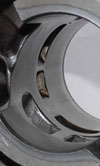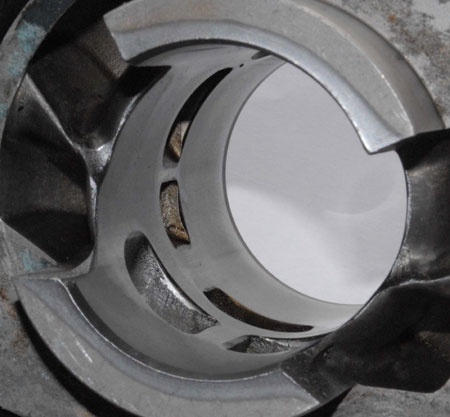Recycling in Motorsport
 With a greater emphasis on waste and recycling in our private lives, is it no wonder that the ethos is now beginning to spill over into the world of competition. While once engine component parts might have been discarded in favour of new replacements, today, where possible, they may be reclaimed to race another day. No better example of this is the re-plating of aluminium motorcycle engine barrels; particularly those that tend to suffer most distress - those of two-stroke engines.
With a greater emphasis on waste and recycling in our private lives, is it no wonder that the ethos is now beginning to spill over into the world of competition. While once engine component parts might have been discarded in favour of new replacements, today, where possible, they may be reclaimed to race another day. No better example of this is the re-plating of aluminium motorcycle engine barrels; particularly those that tend to suffer most distress - those of two-stroke engines.
The bore of any port-scavenged two-stroke engine is always vulnerable. With the piston ring sliding over often cavernous exhaust ports, flanked by even more transfer ports, the opportunity for some form of breakdown in the lubrication between the ring and bore is always very likely. Scoring below the exhaust and transfer ports is highly likely while that above them indicates a more serious issue. In both cases however, loss in engine performance will almost certainly result and the only way to correct the situation is to re-plate.
After dismantling and cleaning (using hot immersion, jet spray cleaners or even ultrasonics), the existing plating has to be removed. Since this is only a few thousands of an inch thick machining it out is totally impractical. Although many re-platers prefer to keep this aspect secret, the nickel substrate in a nickel/ceramic surface can be stripped off using either a chemical or an electrolytic technique and sometimes a combination of the two. Thus while the nickel can be stripped using a Laybere solution consisting of three parts concentrated sulphuric acid to two parts water, nitric acid or a solution of aluminium potassium sulphate will do the job as well. Some will strip away the plating quicker than others but all are highly dangerous giving off toxic fumes and so need to be carried out by specialists with the correct equipment and fume extraction apparatus. Hence as the plating is removed, the aluminium casting remaining will be left totally unaffected.

At this point it is as well to remember that if any port re-profiling is to be undertaken, it should be done at this stage. Re-profiling a port after plating risks part of the plating coming away if done incorrectly and so at this stage it is advisable to remove any sharp edges and gently trim away any areas, which might cause the ring to 'pick-up' in later use. If the bore has been scored at some point and the score has gone through the original plating then since the plating process will not cover even the smallest of scores, the surface may need to be welded and then re-machined back to the nominal size. Methods of re-welding and the filler rods used depend very much on the original barrel material composition, but when fully washed and cleaned again, plating can commence. Although the plating of aluminium bores is highly competitive with few, if any organisation swilling to explain in detail, these processes generally consist of a homogenous mixture of nickel salts and finely divided ceramic powder flowing over and through the cylinder liner using a central anode, with the liner/barrel itself acting as the cathode. Deposition rates will vary according to the size of the component and the current drawn. In the end the coating will consist of two components: a hardened metal matrix into which is evenly dispersed (to about 12-15%), an extremely hard ceramic powder. The plating thickness is targeted at around 0.004in but this has to be chosen to suit the piston diameter and the clearance desired.
Because of the hardness of such a coating (apparent hardness - Hv 580-680), finishing will consist of a diamond honing process, configured to give a surface finish of 0.05 Ra.
So the next time you think about making a coffee table out of that old block, maybe a little bit of old-fashioned re-cycling is called for?
Fig. 1 - Plated bore
Written by John Coxon